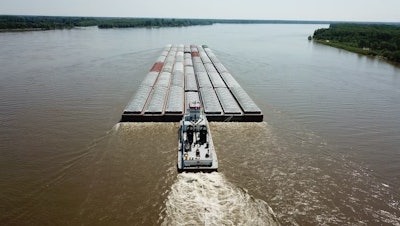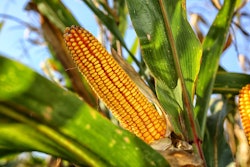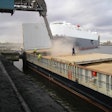
Barge freight rates are sharply increasing due to low water levels on the Mississippi River.
According to the American Farm Bureau Federation's latest Market Intel, drought and dryness in the Midwest has once again dropped water levels on the Mississippi, which is a major thoroughfare for grain, to levels threatening barges’ ability to effectively navigate.
The river is a significant inland waterway for grain movements. Between 2015 and 2019, 95% of corn, 94% of soybeans and 45% of wheat moved by barge traveled through the Mississippi River system to Louisiana. This corresponds to an average annual volume of 32 million tons of corn, 33 million tons of soybeans and 9 million tons of wheat traveling to Louisiana.
According to the U.S. Army Corps of Engineers, the stage, or height of the river’s surface relative to the zero-stage level of 379 feet above standard sea level at St. Louis is 1.13 ft as of August 22, 46% lower than the prior three-year average of 4.37 feet and 24% below last year’s level of 1.49 feet on the same day. Average stage levels for the month of August remain slightly above last year’s, though levels may drop lower.
According to the Market Intel report, the industry generally responds to low water levels by reducing draft allowance, which reduces the volume of goods moved. Beyond draft allowances, the industry often reduces tow sizes. Combined, this means more barges will be needed to move the same quantity of products and more boats will be needed to move smaller groups of barges, pressuring capacity and slowing downstream user efficiency.
Pressured capacity in barges and boats usually increases competition for transportation, pushing up costs for shippers looking to get product moved.
Freight rates surge
According to a report at Bloomberg, barge rates have climbed 42% this year, 85% over the three-year average.
Barge spot rates as of August 29 in St. Louis are up 49% from last week and 42% from last year at $23.34 a ton. That’s up 85% from the past three-year average, according to USDA data released August 30.
The current barge rate data comes as the U.S. heads into its corn and soybean harvest. Last year, extremely low water levels on the Mississippi stranded more than 2,000 barges, crippling commerce on the vital waterway.
Feeling déjà vu? It's 2022 again
The barge industry faced many obstacles in 2022. Low water levels for the Mississippi River not seen since the 1980s led to barge groundings, short supplies of barges, 17% to 28% reductions in draft size, and 24% to 30% drops in tonnage per barge.
For the first three quarters of 2022, the southbound weekly grain tonnage through the MSR was slightly above the 3-year average. In the fourth quarter, low-water restrictions caused weekly southbound grain to fall significantly below the 3-year average.
- During the week of October 11, 2022, in response to low water issues, barge spot freight rates reached an all-time high of $105.85/ton in St. Louis.
- On October 18, 2022, the water gauge at Memphis, Tennessee, reached an all-time low of -10.79 feet.
- For the week ending December 24, 2022, YTD barged grain shipments were 11% lower than 2021 and 6% lower than the 3-year average.


















